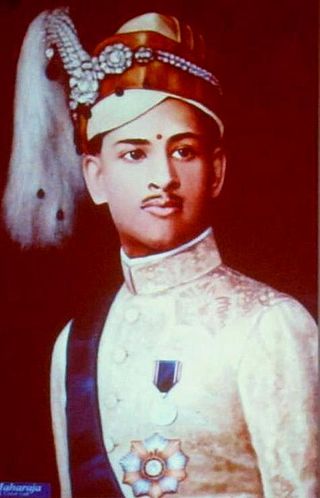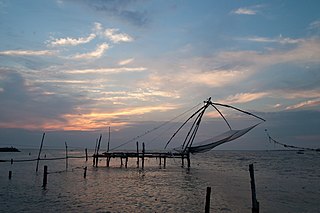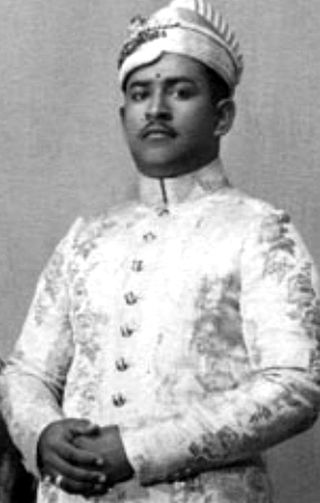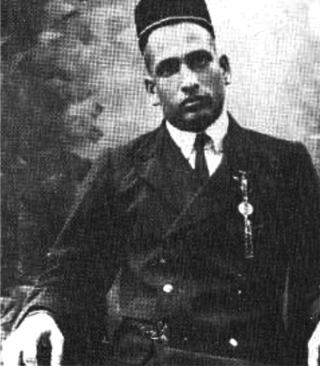
Sree Padmanabhadasa Sree Chithira Thirunal Balarama Varma, popularly known as Sree Chithira Thirunal, was the last ruling Maharaja of the Indian princely state of Travancore, in southern India until 1949 and later the Titular Maharajah of Travancore until 1991. His reign is known for several notable reforms that have indelible impact on the society and culture of Kerala.

The Kingdom of Cochin or the Cochin State, named after its capital in the city of Kochi (Cochin), was a kingdom in the central part of present-day Kerala state. It originated in the early part of the 12th century and continued to rule until its accession to the Dominion of India in 1949.

Kerala Varma Valiya Koil Thampuran ; also spelt Kerala Varma Valiya Koilthampuran and known as Kerala Varma, was a Malayalam - language poet and translator who had an equal facility in writing in English and Sanskrit from the Indian state of Kerala. He was a prince of Parappanad, and consort to the Senior Rani of Attingal and Maharani of Travancore, Bharani Thirunal Lakshmi Bayi, intended to father future sovereigns of Travancore, although the couple was childless, necessitating the adoption of Lakshmi Bayi's grand-nieces. Kerala Varma is also known as the Kalidasa of Kerala, and was both brother-in-law and cousin to painter Raja Ravi Varma, also a prince of Parappanad, though from the Kilimanoor branch, whom he presented with his first oil paints. A third Parappanad prince, his grammarian nephew A. R. Raja Raja Varma, is known as the Panini of Kerala.

Rama Varma Kunji Pillai Thampuran (1751–1805), or Rama Varma IX, popularly known as Sakthan Thampuran, was the ruler of the Kingdom of Cochin. The current southern Indian city of Kochi was part of the erstwhile princely state of Kochi. He resided at Vadakkechira Palace in Thrissur. The city of Thrissur is referred to as the Cultural Capital of Kerala owing to its many traditional festivals and historic temples. Sakthan Thampuran is considered the architect of the city of Thrissur. The festival Thrissur Pooram was started by him.

Pandit Karuppan was a poet, dramatist, and social reformer who lived in Kerala, India.

Kochi is an ancient city located in the Ernakulam District in the Indian state of Kerala about 200 km from Thiruvananthapuram, the capital of Kerala.

Rama Varma I often referred to as Dharma Raja, was the Maharajah of Travancore from 1758 until his death in 1798. He succeeded his uncle Marthanda Varma, who is credited with the title of "maker of modern Travancore". During his reign Dharma Raja not only retained all the territories his predecessor had gained but administered the kingdom with success. He was addressed as Dharma Raja on account of his strict adherence to Dharma Sastra, the Hindu principles of justice by providing asylum to thousands of Hindus and Christians fleeing Malabar during the Mysorean conquest of Malabar.

Sir Sri Ayilyam Thirunal Rama Varma IVGCSI CIE (1832–1880) reigned as Maharaja of Travancore from 1860 to 1880. His reign was highly successful, with Travancore, gaining the appellation of "model state of India", with such celebrated administrators as Raja Sir T. Madhava Rao and Sir A. Seshayya Sastri serving him as Diwans.

)Ramayyan Dalawa was the Dalawa of Travancore state, India, during 1737 and 1756 and was responsible for the consolidation and expansion of that kingdom after the defeat of the Dutch at the 1741 Battle of Colachel during the reign of Maharajah Marthanda Varma, the creator of modern Travancore.

Sree Padmanabhadasa Sree Uthradom Thirunal Marthanda Varma was the titular Maharaja of Travancore. He was the younger brother of the last ruling monarch of the Kingdom of Travancore, Maharajah Chithira Thirunal Balarama Varma.

The Travancore royal family was the ruling house of the Kingdom of Travancore. The Travancore royal family signed a treaty with the British in 1788, thereby adopting British dominance. Later, in 1805, they revised the treaty, leading to a diminution of royal authority and the loss of political independence for Travancore. They had to give up their ruling rights over the common people in 1949 when Travancore were forced to merge with Independent India and their political pension privileges were abolished in 1971.

Sir Sri Rama Varma XV (1852–1932), known as the Rajarshi of Cochin and as Ozhinja Valiya Thampuran, was the ruler of the Kingdom of Cochin from 1895 to 1914.

The Emblem of Kerala is the official seal used by the Government of Kerala to represent the State of Kerala in all its official correspondences. The emblem portrays two elephants guarding the state emblem of India and the Shankh of Sri Padmanabhaswamy according to the history of Kerala.

Kerala Varma Thampuran popularly known as Aikya Keralam Thampuran or Kerala Varma VII was the Maharaja (king) of Cochin who ruled between 1946 and 1949. He mooted the idea of a unified Kerala state in India for the Malayalam speaking population and stood for the merging of British Malabar, Cochin and Travancore. Therefore, he was given the sobriquet Ikyakeralam Thampuran. He died in July 1948. He was also the brain behind the formation of Sree Kerala Varma College at Thrissur, named after him.
Kodungallur Kovilakam, is a palace of the royal family of the late [medieval] Kingdom of Kodungallur (Cranganore), in the modern-day Indian state of Kerala. Kodungallur was a feudal principality subordinate to the rulers of the Kingdom of Cochin from the later half of the eighteenth century until Indian independence. The Kingdom of Kodungallur was under the protection of the Dutch government after 1707 for a few years before returning to its allegiance to the Zamorin. The Kodungallur Royal Family had two branches, at Chirakkal Kovilakam and Puthen Kovilakam.
Parappanad was a former feudal city-state in Malabar, India. The headquarters of Parappanad Royal family was at the town Parappanangadi in present-day Malappuram district. In 1425, the country divided into Northern Parappanad and Southern Parappanad. Southern Parappanad included parts of Tirurangadi Taluk and the town Parappanangadi. Northern Parappanad included Panniyankara, Beypore, and Cheruvannur of Kozhikkode Taluk. Parappanad royal family is a cousin dynasty of the Travancore royal family.

Koyi Thampuran was the title of the Prince Consorts of the Queens and Princesses of Travancore. The Koyi Thampurans' gained prominence and prestige in Kingdom of Travancore as they were the fathers of the then reigning Kings. In Travancore, there were ten clans of Koyi Thampurans. The most ancient were the ones settled at Kilimanoor ; others were Kirthipuram, Pallam, Paliyakkara and Nirazhi, Ananthapuram, Chemprol, Cherukol, Karazhma and Vatakkemadham.

Parukutty Nethyar Amma was the consort of the ruler of the Kingdom of Cochin, Maharaja Rama Varma XVI, who reigned from 1914 to 1932. She had been known as Lady Rama Varma of Cochin.















